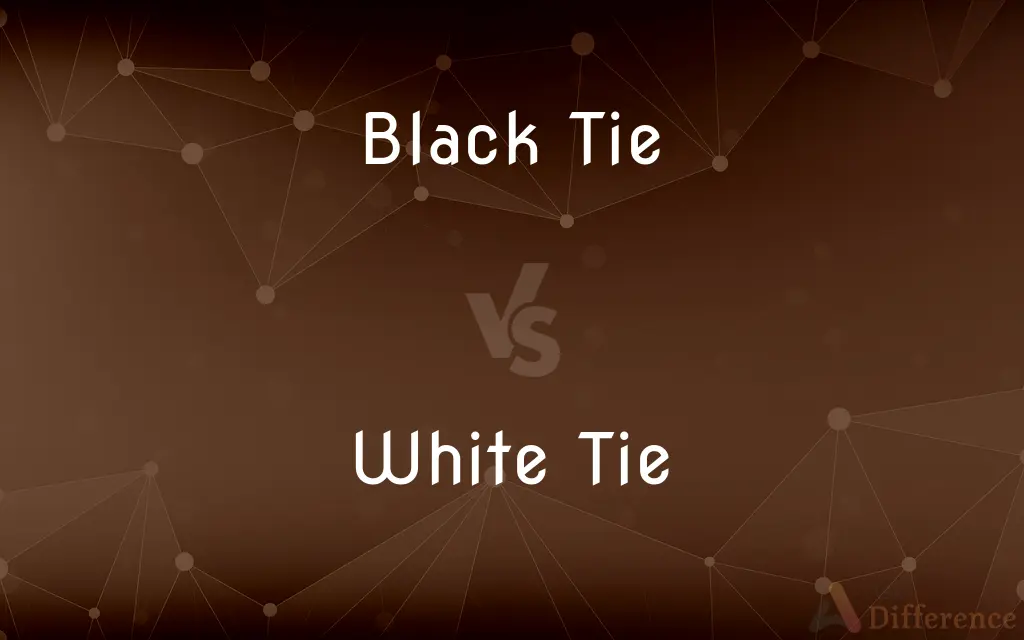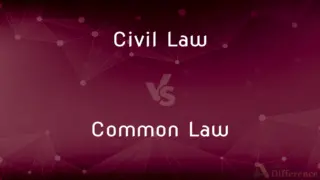Black Tie vs. White Tie — What's the Difference?
By Tayyaba Rehman — Published on October 20, 2023
Black Tie and White Tie refer to formal dress codes, with Black Tie being semi-formal, typically involving tuxedos, and White Tie being the most formal, requiring tailcoats and specific accessories.

Difference Between Black Tie and White Tie
Table of Contents
ADVERTISEMENT
Key Differences
Black Tie and White Tie, while both hallmarks of formal attire, each curate a distinctive aesthetic and level of formality in the realm of sartorial elegance. Black Tie, often deemed semi-formal, ushers in an ensemble that predominantly features a black tuxedo or dinner jacket paired with a black bow tie. Conversely, White Tie unequivocally represents the pinnacle of formal attire, mandating a black tailcoat, white bow tie, and an array of meticulously selected accessories, exuding unparalleled elegance and strict adherence to dress protocol.
In a Black Tie setting, the attire typically includes a black tuxedo accompanied by a high-degree of flexibility in terms of accessories and additional apparel, allowing for subtle personalization and modernization. The White Tie dress code, in stark contrast, subscribes to an unyielding and meticulously defined set of guidelines that envelop not only the tailcoat and white bow tie but also elements such as the waistcoat, shirt, and even footwear, often leaving little room for individual interpretation or deviation from the established norm.
The realm of appropriate events for Black Tie and White Tie also present clear distinctions, reflecting their respective degrees of formality and inherent ambiance. Black Tie, while decidedly elegant and formal, lends itself to a wide array of events, from evening weddings to sophisticated parties, wherein elegance is paramount, yet a slightly relaxed ambiance prevails. White Tie, however, is invariably reserved for occasions of utmost formality and tradition, such as state dinners, formal balls, and certain high-profile ceremonies, wherein the event itself necessitates an air of utmost sophistication and adherence to traditional etiquette.
Considering versatility and global applicability, Black Tie arguably enjoys a wider sphere of acceptance and engagement, being recognized and utilized across numerous cultures and contexts for various formal events. White Tie, while universally recognized as the epitome of formality, is less frequently employed, given its exceedingly formal nature and strict sartorial requisites, rendering it predominantly pertinent to highly traditional or ceremonious occasions, often within specific cultural or societal contexts.
Thus, while both Black Tie and White Tie manifest as conduits of elegance and formality, the latter invariably resides a tier above, engendering a sartorial echelon that demands unwavering respect for tradition, detail, and ceremonial etiquette. Both dress codes, while sharing a common thread of sophistication, cater to distinct environments and expectations, with Black Tie offering a semblance of adaptability and modernity, and White Tie staunchly preserving the sanctity of traditional formal wear.
ADVERTISEMENT
Comparison Chart
Level of Formality
Semi-formal
Most formal
Jacket Type
Tuxedo
Tailcoat
Tie Color
Black
White
Usual Occasions
Weddings, Parties
State Dinners, Formal Balls
Flexibility
Some flexibility allowed
Strict, with little to no flexibility
Compare with Definitions
Black Tie
A semi-formal evening dress code.
He chose a sleek tuxedo for the Black Tie event.
White Tie
The most formal evening dress code.
The state dinner required White Tie attire, demanding utmost elegance.
Black Tie
Typically involves wearing a tuxedo.
Black Tie affairs often showcase a variety of tuxedo styles.
White Tie
Enforces a strict and detailed dress protocol.
Every accessory, from the cufflinks to the shoes, was considered in the White Tie dress code.
Black Tie
Offers some flexibility in accessories.
At the Black Tie event, some chose cummerbunds while others preferred waistcoats.
White Tie
Typically reserved for highly ceremonious occasions.
White Tie is often seen at royal balls and state dinners.
Black Tie
Appropriate for a wide array of formal events.
Black Tie attire was suitable for the elegant evening wedding.
White Tie
Necessitates the wearing of a tailcoat.
For the White Tie event, he selected a well-tailored tailcoat.
Black Tie
Generally involves black-colored bow ties.
His silk black bow tie complemented his tuxedo at the Black Tie gala.
White Tie
Demands a white bow tie specifically.
His white bow tie was perfectly tied for the White Tie event.
Black Tie
A black bow tie worn with a tuxedo.
White Tie
A white bow tie worn as a part of formal evening dress.
Black Tie
Semiformal evening wear, usually requiring a tuxedo for men and an evening gown or cocktail dress for women.
White Tie
Formal evening wear, usually requiring a tailcoat for men and an evening gown for women. White tie is considered the most formal category of evening wear.
Black Tie
Moderately formal; usually requiring a dinner jacket (tuxedo) for men.
White Tie
Of an event: very formal; usually requiring a tailcoat for men.
Black Tie
Requiring semiformal evening clothes, e. g. a black bowtie and a tuxedo or dinner jacket for men, and a formal dress for women; contrasted with white-tie, for a fully formal occasion, and with informal, and casual.
White Tie
Requiring formal evening clothes, usually interpreted as a white bow tie and a tailcoat for men, and a formal evening dress for women; - as, a white-tie reception at the embassy. Contrasting with black-tie and informal.
Black Tie
Moderately formal; requiring a dinner jacket;
He wore semiformal attire
A black-tie dinner
White Tie
Requiring white ties and tailcoats for men;
A white-tie occasion
Common Curiosities
Can a colored bow tie be worn for Black Tie events?
Traditionally, a black bow tie is worn, but modern events may allow some variations.
What distinguishes White Tie from Black Tie?
White Tie is more formal than Black Tie, requiring a tailcoat and specific accessories.
Is a tailcoat necessary for White Tie events?
Yes, a black tailcoat is a fundamental component of White Tie attire.
Are Black Tie events strictly evening affairs?
Typically, yes, Black Tie is designated for evening events.
Are women’s dress codes different for Black Tie and White Tie?
Yes, typically women wear evening gowns for Black Tie and more elaborate gowns for White Tie.
Can accessories be colorful in Black Tie attire?
Some modern Black Tie events may allow colorful accessories, but tradition emphasizes black and white.
What kind of footwear is appropriate for White Tie?
Typically, patent leather court shoes are worn with White Tie attire.
Can I wear a colored shirt for a Black Tie event?
Traditionally, a white shirt is worn, but some modern Black Tie events may allow variations.
Can I wear a necktie for a Black Tie event?
Traditionally, a black bow tie is standard, but some contemporary settings might permit a necktie.
What type of jacket is worn in Black Tie attire?
A tuxedo is traditionally worn in Black Tie attire.
Is White Tie common in modern events?
White Tie is less common and usually reserved for extremely formal, often traditional events.
Can I wear a black bow tie to a White Tie event?
No, a white bow tie is required for White Tie attire.
Are vest options different between Black Tie and White Tie?
Yes, Black Tie typically features a black vest or cummerbund, while White Tie requires a white piqué vest.
Are gloves required for White Tie?
Men usually wear white gloves, while it’s optional for women.
Can I wear a regular suit for a Black Tie event?
A tuxedo is traditional for Black Tie, and a regular suit is generally not formal enough.
Share Your Discovery

Previous Comparison
Civil Law vs. Common Law
Next Comparison
Common Intention vs. Common ObjectAuthor Spotlight
Written by
Tayyaba RehmanTayyaba Rehman is a distinguished writer, currently serving as a primary contributor to askdifference.com. As a researcher in semantics and etymology, Tayyaba's passion for the complexity of languages and their distinctions has found a perfect home on the platform. Tayyaba delves into the intricacies of language, distinguishing between commonly confused words and phrases, thereby providing clarity for readers worldwide.
















































